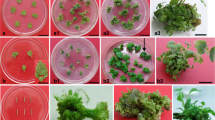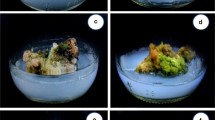Abstract
An effective in vitro propagation system via organogenesis was developed for Cotyledon orbiculata, a valuable medicinal plant. Plant regeneration and morphogenesis in vitro of C. orbiculata was initiated from leaf explants using various concentrations and combinations of plant growth regulators (PGRs). The highest number of regenerated shoots (20.0 ± 1.64) and shoot length (2.36 ± 0.27 cm) per explant was obtained on Murashige and Skoog (MS) medium supplemented with a combination of 5 µM thidiazuron and 2.0 μM benzyladenine. The regenerated shoots were elongated (6.47 ± 1.02 cm) when transferred to half-strength MS medium. Elongated shoots rooted (39.60 ± 1.27 per shoot) best in a half-strength MS medium containing 10 μM indole-3-butyric acid. Plantlets were successfully acclimatized (100 %) in a vermiculite-soil mixture (1:1 v/v) in the greenhouse. Rooting was also achieved ex vitro during acclimatization in a vermiculite-soil mixture (1:1 v/v) in the greenhouse with good plant growth. Different tissue types from in vitro culture (callus, shoots and plantlets) and leaves from ex vitro plants exhibited antibacterial activity [minimum inhibitory concentration (MIC) from 0.098 to 0.78 mg ml−1] against both Gram-positive and Gram-negative bacteria. In vitro and ex vitro developed plant tissues showed antibacterial activity (MIC of 0.195–0.78 mg ml−1) specifically against Klebsiella pneumoniae. Despite this, generally the leaf of ex vitro plants gave good activity (MIC of 0.195–0.78 mg ml−1) against both Gram-positive and Gram-negative bacteria. The present study indicated that tissue-culture-derived calli, shoots and plantlets, and ex vitro acclimatized leaves influenced therapeutic potential by the PGRs treatment used in the tissue culture system. The in vitro regenerated plants and its tissues of C. orbiculata using this protocol can be utilized as therapeutic agents for traditional medicine and for ex situ conservation.


Similar content being viewed by others
References
Banasiuk R, Kawiak A, Krolicka A (2012) In vitro cultures of carnivorous plants from the Drosera and Dionaea genus for the production of biologically active secondary metabolites. BioTechnologia 93:87–96
Baskaran P, Singh S, Van Staden J (2013) In vitro propagation, proscillaridin A production and antibacterial activity in Drimia robusta. Plant Cell Tissue Org Cult 114:259–267
Baskaran P, Chukwujekwu JC, Amoo SO, Van Staden J (2014a) Anticholinesterase and mutagenic evaluation of in vitro-regenerated Agapanthus praecox grown ex vitro. In Vitro Cell Dev Biol Plant 50:271–275
Baskaran P, Moyo M, Van Staden J (2014b) In vitro plant regeneration, phenolic compound production and pharmacological activities of Coleonema pulchellum. S Afr J Bot 90:74–79
Daksa J, Abera B, Taddese T (2015) Micropropagation of Phytolacca dodecandra L ‘Herit (Endod var. E-44). Afr J Biotechnol 14:108–118
Distabanjong K, Geneve RL (1997) Multiple shoot formation from cotyledonary node segments of Eastern redbud. Plant Cell Tissue Org Cult 47:247–254
Eloff JN (1998) A sensitive and quick microplate method to determine the minimal inhibitory concentration of plant extracts for bacteria. Planta Med 29:129–132
Frello S, Venerus E, Serek M (2002) Regeneration of various species of Crassulaceae, with special reference to Kalanchoe. J Hortic Sci Biotechnol 77:204–208
García-Pérez E, Gutiérrez-Uribe JA, García-Lara S (2012) Luteolin content and antioxidant activity in micropropagated plants of Poliomintha glabrescens (Gray). Plant Cell Tissue Org Cult 108:521–527
Georgiev V, Ivanov I, Berkov S, Pavlov A (2011) Alkaloids biosynthesis by Pancratium maritimum L. shoots in liquid culture. Acta Physiol Plant 33:927–933
Hepaksoy S, Aksoy U (2006) Propagation of Ficus carica L. clones by in vitro culture. Biol Plant 50:433–436
Kitamura Y, Kubo K, Rahman LU, Ikenaga T (2002) Reproduction of Sedum drymarioides, an endangered rare species, by micropropagation. Plant Biotechnol 19:303–309
Kordi M, Kaviani B, Hashemabadi D (2013) In vitro propagation of Kalanchoe blossfeldiana using BA and NAA. Eur J Exp Biol 3:285–288
Kumari A, Baskaran P, Van Staden J (2015) Enhanced HIV-1 reverse transcriptase inhibitory and antibacterial properties in callus of Catha edulis Forsk. Phytother Res 29:840–843
Murashige T, Skoog F (1962) A revised medium for rapid growth and bio assays with tobacco tissue cultures. Physiol Plant 15:473–497
Nabi SA, Rashid MM, Al-Amin M, Rasul MG (2002) Organogenesis in teasle gourd (Momordica dioica Roxb.). Plant Tissue Cult 12:173–180
Nagao EO, Pasqual M, Ramos JD (1994) Efeitos da sacarose e do nitrogênio inorgânico sobre a multiplicação in vitro de brotações de porta-enxerto de citros. Bragantia 53:25–31
Sajc L, Grubisic D, Vunjak-Novakovic G (2000) Bioreactors for plant engineering: an outlook for further research. Biochem Eng J 4:89–99
SANBI (2014) Statistics: red list of South African plants version 2014.1. http://redlist.sanbi.org/species.php. Assessed 20 March 2014
Skirvin RM, Chu MC, Rukan H (1980) An improved medium for the in vitro rooting of Harbrite peach. Proc. III State Hortic Soc 113:30–38
Smith CA (1966) Common names of South African plants. Memoirs of the botanical survey of South Africa. Department of Agricultural Technical Services, Pretoria
Solís JJ, Reyna M, Feria MD, Cardona MA, Rojas D (2013) In vitro propagation of Echeveria elegans, a species of the flora endangered Mexican. J Environ Sci Eng B 2:555–558
Steyn PS, Van Heerden FR, Vleggaar R, Anderson LAP (1986) Bufadienolide glucosides of the Crassulaceae. Structure and stereochemistry of orbicusides A-C, novel toxic metabolites of Cotyledon orbiculata. J Chem Soc Perkin Trans 1:1633–1636
Tölken HR (1985) The genus Cotyledon. Flora South Afr 14:3–17
Van Wyk BE, Van Oudtshoorn B, Gericke N (1997) Medicinal plants of South Africa. Briza Publications, Pretoria
Watt JM, Breyer-Brandwijk MG (1962) Medicinal and poisonous plants of Southern and Eastern Africa. E & S. Livingstone Ltd., Edinburgh
Zhao Y, Stiles AR, Saxena PK, Liu CZ (2013) Dark preincubation improves shoot organogenesis from Rhodiola crenulata leaf explants. Biol Plant 57:189–192
Ziv M (1991) Vitrification: morphological and physiological disorders of in vitro plants. In: Debergh PC, Zimmerman ES (eds) Micropropagation. Kluwer Academic Publisher, Dordrecht, pp 45–69
Acknowledgments
Financial support by the National Research Foundation (NRF), Pretoria and the University of KwaZulu-Natal, Pietermaritzburg is gratefully acknowledged. The authors are grateful to the Microscopy and Microanalysis Unit (MMU), UKZN, Pietermaritzburg for microscopic assistance.
Author information
Authors and Affiliations
Corresponding author
Ethics declarations
Conflict of interest
The authors declare that they have no conflict of interest.
Rights and permissions
About this article
Cite this article
Kumari, A., Baskaran, P. & Van Staden, J. In vitro propagation and antibacterial activity in Cotyledon orbiculata: a valuable medicinal plant. Plant Cell Tiss Organ Cult 124, 97–104 (2016). https://doi.org/10.1007/s11240-015-0878-0
Received:
Accepted:
Published:
Issue Date:
DOI: https://doi.org/10.1007/s11240-015-0878-0




